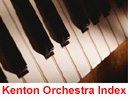Stan Kenton always maintained his latest orchestra was his greatest, but there can be no doubt the Innovations ensemble, expanded to 40 pieces and including 16 strings, occupied a special place in his affections.
Nowhere are classical sounds and devices tacked onto jazz in some superficial fashion. Rather, the composers achieved an original and musically valid blend, a highly effective synthesis of formal, modern concert music with the excitement and dynamism of big band jazz. Many talents went into Innovations, but the man at the center, the catalyst who brought it all together by the power of his musical personality was Stan Kenton.
Bill
Russo wrote
'Solitaire' in 1948, when he called it 'Falstaff.' On 'Lonesome Road,' the dark, brooding mood of the introduction contrasts vividly with the exhilarating trumpet flights of the up-tempo passage. Every now and again you know Maynard Ferguson is among the personnel. But the star is Christy, who sings with a classical purity of tone in perfect keeping with Rugolo's intentions. June is faultless in this very demanding role. By means of Latin rhythms and pizzicato strings, 'Trajectories' depicts composer Franklyn Marks' impressions as he watches a galaxy of falling stars, culminating in a fantasy as the entire heavens break loose, an experience Marks finds fascinating and spectacular, and in no way threatening. The restlessness and constantly changing rhythmic patterns of 'Trajectories' are an especially original concept. Bob Graettinger differs from Stan's other composers, who despite all the dissonance and modernity in their writing, display a sense of order and symmetry, which Graettinger spurns. Bob's work lacks a sequential pattern and regularity and is deliberately asymmetrical, making it at once more difficult to comprehend, yet potentially more rewarding in its very unpredictability. Despite the lively theme and jaunty tempo, 'Incident In Jazz' is never lightweight or frivolous, due to the atonal nature of Graettinger's complex orchestration. Like many of Bob's pieces, the work ends on a surprisingly tranquil note, in marked contrast to the proceeding orchestral counterpoint and dissonance. Stan's fascination in fusing Afro-Cuban rhythms with big band jazz never wavered, and authenticity is assured in Cuban-born Chico O'Farrill's feature for the conga drums and fiery vocals of Carlos Vidal. 'Cuban Episode' is a multi-tempoed creation that unites exotic Latin rhythms with the incisive Kenton brass in a passionate combination of the two cultures. Sights and sounds of the Orient are perceptively explored via a bolero beat in Franklyn Mark's 'Evening In Pakistan' (or 'Kenton in Karachi' as one wag termed it). The lovely introduction is especially sensitive writing, and note also the extent to which the mood throughout is determined by the hypnotic rhythms played by tambourine and finger cymbals.
"The impact and sensation derived from feeling a powerful beat will never be dulled, nor should it be ignored," was the way Stan introduced 'Jolly Rogers' in concert. Shorty's first score for Stan is full frontal bebop, an exuberant explosion of swinging jazz. Rugolo's artful 'Blues In Riff' is more laid-back, and both charts serve to introduce the 'cool' concepts of soloists Art Pepper, Bob Cooper and Shorty Rogers. I am convinced no other percussion player could have switched so dexterously from his pivotal position on the complex concert compositions, to his role as bebop jazz drummer, as the late, great Shelly Manne. When featuring a non-jazz instrument like the cello, played here by classical virtuoso Gregory Bemko, there is a very fine line between music that is virtually classical in conception, and 'light' music of the Kostelanetz kind. Almeida's 'Cello-logy' brilliantly finds that middle ground, veering towards the classical rather than the benign, but never forsaking Kenton's roots via modern writing for the strings, and especially the use of jazz rhythmic patterns and devices. Shorty Rogers noted: "Stan and Pete both encouraged me to write, and the things I did for Innovations were my first attempts to write for an orchestra on a larger scale. Stan had me write a composition to feature Art Pepper. Art did a magnificent job on the record, and he remains to this day one of our greatest jazz performers." In contrast, 'Halls Of Brass' is an ensemble work. One would imagine written by a trained composer, though Russo is quick to point out that was not the case: "I was 22 when I wrote 'Halls Of Brass,' schooled only in the sense I went to the library and read a lot. I think it extraordinary I was able to do whatever I did. 'Halls' was very hard to play, and very hard to conduct, and I do think more highly of it than some of the others." Kenton disliked understatement, and valued musicians gifted with extraordinary technique. Maynard Ferguson was Stan's idea of trumpet heaven, and that extra bite in the section when Maynard was present is self-evident. Ferguson's higher-than-high-note technique is graphically demonstrated in this showcase for solo trumpet. Somehow, Stan found the time to write two solo features himself. 'Shelly Manne' is a compellingly dramatic work, and certainly far from Hollywoodish." As Shelly said: "I have always thought the usual drum solos are banal and tasteless, and 'Shelly Manne' is not a drum solo, but a blending of my percussion sound and ideas with Stan's orchestral composition."
'Round Robin' started life as a jazz chart for the dance orchestra that played between the two Innovations tours. It's a swinging showcase far the band's new brand of understated soloists -- Rogers, Cooper and Pepper in that order. In 1951, Shorty rescored his theme as a title feature for Conte Candoli on the second Innovations tour. 'Coop's Solo' (aka 'Bob Cooper') is a companion piece to 'Art Pepper.' Bob's beautiful tone is perhaps his greatest asset, again comparable to Art. 'Sambo' is one of Shorty's most original and exciting excursions into Latin territory, the title a combination of samba and mambo, the music a fusion of Brazil's popular dance rhythms with Kenton jazz. It's an electrifying performance, one of those super-charged swingers that never subsides, with Ferguson's trumpet soaring above the ensemble, and the rhythm animated by Manne's vital percussion work. The final four tracks derive from a public concert at Cornell University in Ithaca, New York. 'Ennui' is on the same lines as Russo's 'Solitaire' a lovely melody, beautifully articulated by soloist Harry Betts. Manny Albam's 'Samana' stems from the torrid pulse of Cuban music, and opens with percussive trombone effects similar to those devised by Albam for Charlie Barnet's 'Pan-Americana.' It's a tension-building arrangement that never lets up until the explosive finale. 'Coop's Solo,' employs the strings to introduce this longer, concert version of the Shorty Rogers' composition and Bob Cooper comes on strong, playing with great confidence, lyricism and authority. The closing 'Salute,' repeated from the first season, may not have quite the perfect recording balance attained in the studio, but the playing benefits from the familiarity of nightly performances. The spirit of Spain is vividly captured in this fiery, assertive interpretation that surpasses even the original version, The roar of applause at the end is a salute to Stan Kenton, which we echo almost 50 years after the event. For seldom, if ever, can such a quixotic enterprise as Innovations have produced such a tangible record of original, creative music. The recorded evidence of these CDs is proof indeed of the enduring legacy of Stan's greatest musical adventure. --
Michael Sparke |
|||
 |
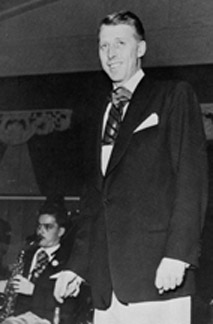
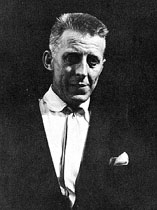
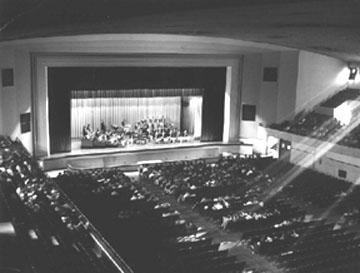 Innovations
was
the nearest he would ever come to his ideal of a permanently-organized
concert orchestra, playing America's finest auditoriums, and featuring
a new and exciting brand of Progressive American Music. That this
repertoire
is even more meaningful today than at its inception is due largely to
the
way the composers integrated the different types of music.
Innovations
was
the nearest he would ever come to his ideal of a permanently-organized
concert orchestra, playing America's finest auditoriums, and featuring
a new and exciting brand of Progressive American Music. That this
repertoire
is even more meaningful today than at its inception is due largely to
the
way the composers integrated the different types of music.
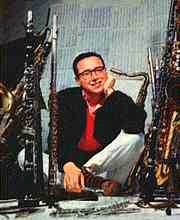 By his
side was
the talented Pete Rugolo, whose mastery of the orchestra's wide tonal
range
is manifest throughout
'Mirage,'
a skillfully crafted descriptive work depicting the gradual formation,
realization, and slow disintegration of this illusionary fantasy.
'Conflict'
was first composed in 1948, without the strings. Described as a tone
poem
that portrays the alternating feelings of happiness and anxiety that
constantly
vie for priority within our subconscious minds, Christy's instrumental
vocalization has a vital, distinctive timbre, almost resembling a
low-pitched
clarinet. The concept is not new, but Rugolo has transformed the genre
by translating it into the Kenton canon.
By his
side was
the talented Pete Rugolo, whose mastery of the orchestra's wide tonal
range
is manifest throughout
'Mirage,'
a skillfully crafted descriptive work depicting the gradual formation,
realization, and slow disintegration of this illusionary fantasy.
'Conflict'
was first composed in 1948, without the strings. Described as a tone
poem
that portrays the alternating feelings of happiness and anxiety that
constantly
vie for priority within our subconscious minds, Christy's instrumental
vocalization has a vital, distinctive timbre, almost resembling a
low-pitched
clarinet. The concept is not new, but Rugolo has transformed the genre
by translating it into the Kenton canon.
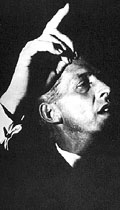 Bill
told me: "It was Stan who changed the name to 'Solitaire,' because the
piece has a certain solitary quality. Only the trombones' first chorus
and closing bars were written out, the remainder being chord symbols,
so
the soloist could impose his own sense of jazz improvisation and
structure.
Milt (Bernhart) did a very fine job." Those who associate Johnny
Richards
exclusively with the blazing excitement of 'Cuban Fire' and similar
extravaganzas,
may be surprised by the tenderness and sensitivity of 'Soliloquy'
described
as illustrating the mood in a musician's mind after the noise and
excitement
of a concert has died and he is left with his own reflections. Notice
how
effective is Bud Shank's flute work; especially as Bud had only
recently
perfected his flute technique in order to gain a place in the
Innovations
personnel. Kenton was quoted as saying he feared his own 'Theme For
Sunday'
would sound Hollywoodish, in the sense that the melodious strings are
more conventionally employed than by the band's other writers. Stan's
elegant theme is graced with highly effective voicing and features the
composer's romantic piano styling. 'Arnazonia' could equally well have
been named Laurindo Almeida, in honor of its featured soloist, who also
composed this
exquisite work for strings and concert guitar. The mood is generally
calm
and tranquil, in contrast to the dynamic passage for agitato strings
preceding
the up-tempo Latin section.
Bill
told me: "It was Stan who changed the name to 'Solitaire,' because the
piece has a certain solitary quality. Only the trombones' first chorus
and closing bars were written out, the remainder being chord symbols,
so
the soloist could impose his own sense of jazz improvisation and
structure.
Milt (Bernhart) did a very fine job." Those who associate Johnny
Richards
exclusively with the blazing excitement of 'Cuban Fire' and similar
extravaganzas,
may be surprised by the tenderness and sensitivity of 'Soliloquy'
described
as illustrating the mood in a musician's mind after the noise and
excitement
of a concert has died and he is left with his own reflections. Notice
how
effective is Bud Shank's flute work; especially as Bud had only
recently
perfected his flute technique in order to gain a place in the
Innovations
personnel. Kenton was quoted as saying he feared his own 'Theme For
Sunday'
would sound Hollywoodish, in the sense that the melodious strings are
more conventionally employed than by the band's other writers. Stan's
elegant theme is graced with highly effective voicing and features the
composer's romantic piano styling. 'Arnazonia' could equally well have
been named Laurindo Almeida, in honor of its featured soloist, who also
composed this
exquisite work for strings and concert guitar. The mood is generally
calm
and tranquil, in contrast to the dynamic passage for agitato strings
preceding
the up-tempo Latin section. 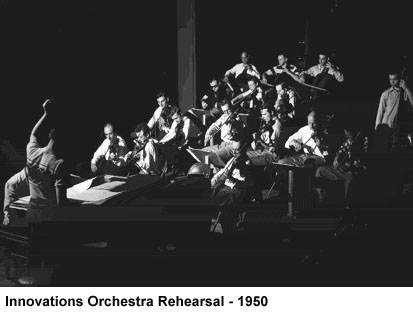 'Salute' is
Rugolo's
contribution to Latin-American relations, and again demonstrates Pete's
command of the large orchestra, and his ability to compose the most
compelling
themes. It's a stirring, emotionally exciting flag-waver that Stan
often
used as a concert closer. 'Mardi Gras' (also issued as 'Playtime In
Brazil')
is infectiously festive and convivial, an oddity that features "The
Kenton
Band and Their Families" chanting a wordless vocal to a catchy Latin
melody.
Stan explained; "It isn't music, but an attempt to create a holiday
spirit."
Neal Hefti's 'In Veradero' is a musical portrait described via a
lightly
hypnotic Latin beat and exciting orchestral work, of a township south
of
the border. Notable are Hefti's tuneful melody and skillful arranging,
with the band humming effectively behind Bud Shank's nimble flute, and
a beautiful tenor solo by the underrated Bob Cooper.
'Salute' is
Rugolo's
contribution to Latin-American relations, and again demonstrates Pete's
command of the large orchestra, and his ability to compose the most
compelling
themes. It's a stirring, emotionally exciting flag-waver that Stan
often
used as a concert closer. 'Mardi Gras' (also issued as 'Playtime In
Brazil')
is infectiously festive and convivial, an oddity that features "The
Kenton
Band and Their Families" chanting a wordless vocal to a catchy Latin
melody.
Stan explained; "It isn't music, but an attempt to create a holiday
spirit."
Neal Hefti's 'In Veradero' is a musical portrait described via a
lightly
hypnotic Latin beat and exciting orchestral work, of a township south
of
the border. Notable are Hefti's tuneful melody and skillful arranging,
with the band humming effectively behind Bud Shank's nimble flute, and
a beautiful tenor solo by the underrated Bob Cooper.
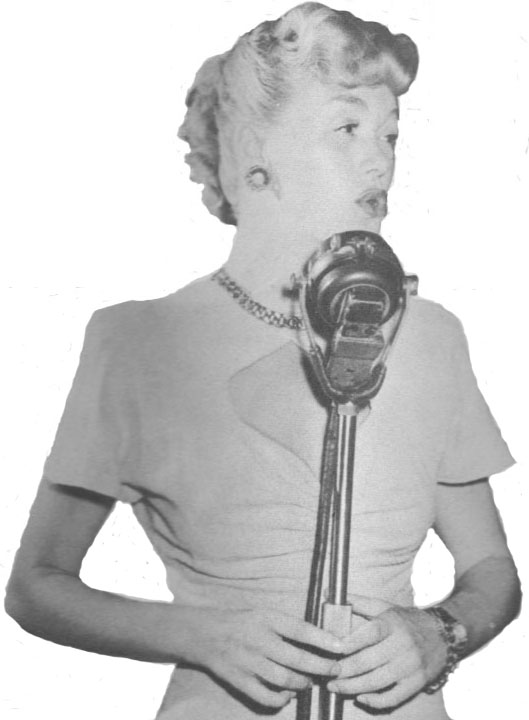 Equally
successful is 'June Christy' on which Stan allows June the freedom to
employ the human voice as a wordless instrument, backed only by an
8-piece rhythm section. Stan found Graettinger's first 'House Of
Strings' lacking, and caused him to rewrite the piece. Thus no doubt
putting the composer on his mettle. Kenton told Bob's biographer (Bob
Morgan): "I was thrilled with the new 'House Of Strings,' and from that
time on, everything that Graettinger wrote I didn't contest at all,
because I felt that he had arrived, and he knew what he was
doing."
Equally
successful is 'June Christy' on which Stan allows June the freedom to
employ the human voice as a wordless instrument, backed only by an
8-piece rhythm section. Stan found Graettinger's first 'House Of
Strings' lacking, and caused him to rewrite the piece. Thus no doubt
putting the composer on his mettle. Kenton told Bob's biographer (Bob
Morgan): "I was thrilled with the new 'House Of Strings,' and from that
time on, everything that Graettinger wrote I didn't contest at all,
because I felt that he had arrived, and he knew what he was
doing." 